LG C1 vs Samsung QN90A: Which should you buy?
Two of the best TVs of the year enter the ring. Only one leaves.
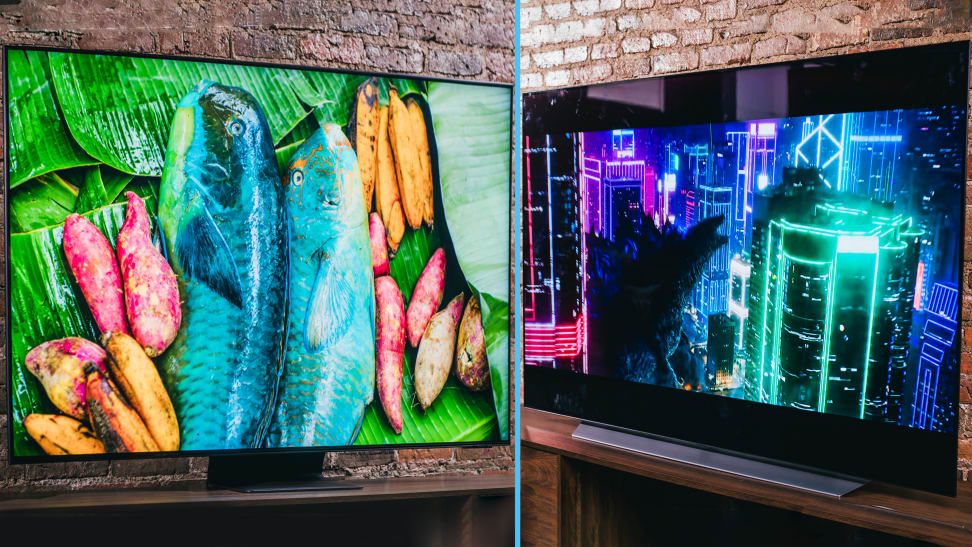 Credit:
Reviewed / Jackson Ruckar
Credit:
Reviewed / Jackson Ruckar
Products are chosen independently by our editors. Purchases made through our links may earn us a commission.
If you have your heart set on a high-end TV with spectacular performance and exciting, future-facing features, there are two TVs that have risen to the top this year: the LG C1, a top-tier 4K OLED TV, and the Samsung QN90A, Samsung’s flagship 4K Neo QLED TV.
But despite the impressive mantle they both uphold, these two luxe TVs achieve their superiority in vastly different ways. Understanding those differences will play a major role in determining which is the better fit for you. That’s why we’ve put these two heavy-hitters up against one another in a head-to-head matchup. By the end of this exercise, you should be well on your way to investing in an award-winning TV with utmost confidence.
Buy the Samsung Q90A at Amazon
Price
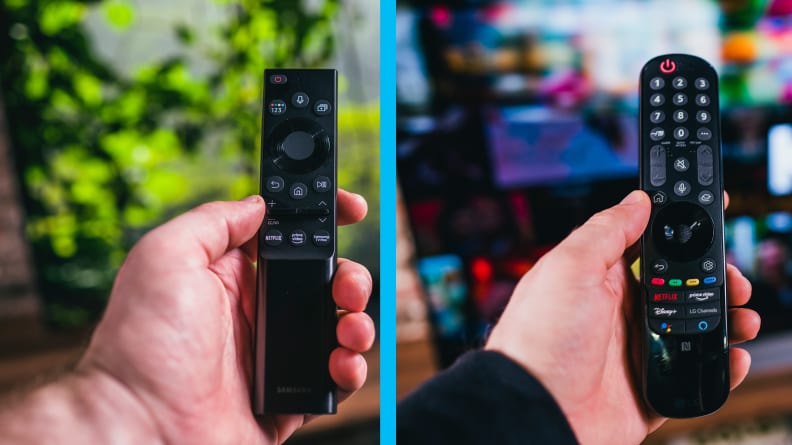
On the left is the new version of LG's Magic Remote. On the right is Samsung's new solar-powered, rechargeable remote control. Both come with every size option in each of the two series.
These are two of the best TVs you can buy so it stands to reason that they’re priced at a premium.
Before we take a look at their respective prices, note that these are the original price points and not necessarily the prices you’ll encounter while shopping today. For example, at the time of writing, both the LG C1 and the Samsung QN90A are on sale for prices far below their original MSRP. This can obviously change at any moment, but it’s worth keeping in mind.
LG C1:
- 48-inch (LG OLED48C1PUB), MSRP $1,499.99
- 55-inch (LG OLED55C1PUB), MSRP $1,799.99
- 65-inch (LG OLED65C1PUB), MSRP $2,499.99
- 77-inch (LG OLED77C1PUB), MSRP $3,799.99
The C1 is available in four sizes ranging from 48 to 77 inches. The 48-inch model is a great option for folks who want a premium TV experience at a smaller-than-average size.
Now, let’s take a look at the QN90A.
Samsung QN90A:
- 55-inch (Samsung QN55QN90A), MSRP $1,799.99
- 65-inch (Samsung QN65QN90A), MSRP $2,599.99
- 75-inch (Samsung QN75QN90A), MSRP $3,499.99
- 85-inch (Samsung QN85QN90A), MSRP $4,999.99
The QN90A lineup doesn't offer a model below the 55-inch option, but Samsung is offering the QN90A in a gargantuan 85-inch model—a great pick for people who want a larger-than-life home theater experience. Otherwise, original pricing is quite similar.
Given their tendency to be discounted at this point in their respective lifespans—and given the fact that their respective sale prices shake out to be in the same ballpark—we’re calling this one a tie.
Our pick: Draw
Design

The metallic slab that acts as the C1's stand gently lifts the panel and pushes the TV's audio out towards the viewer.
If you decide to spend up on either one of these incredible flagship TVs, you won’t be let down when it comes to the look and feel of your new TV. Both the C1 and the QN90A are superbly crafted TVs with sturdy materials and eye-catching design flourishes.
Being an OLED TV, the C1 immediately makes an impression with its razor-thin panel, which is (somewhat unbelievably) thinner than most smartphones. The back of the TV bulks out around the midsection where the C1 hides its internals, but even the thickest part of the chassis is less bulky than most TVs.
Its stand design is sensational, too. Rather than sit atop two feet as most contemporary TVs do, the C1 rests on a downward-slanting slab of brushed metal. The tilted angle gives the impression that the TV is being lifted gently off its surface while also directing the TV’s audio straight out to the viewer.
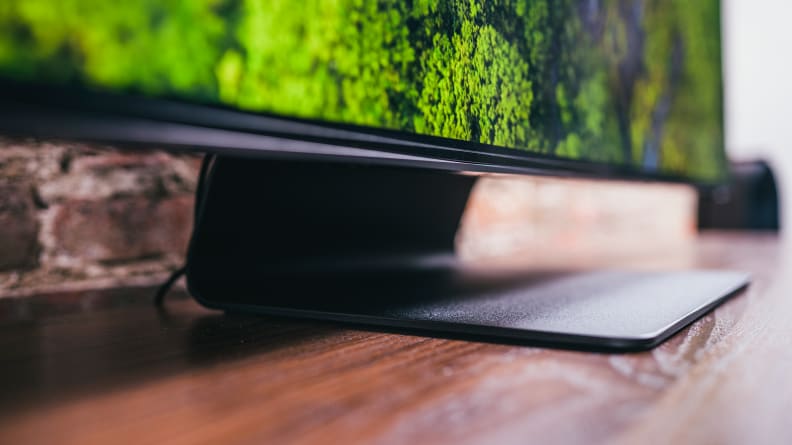
The QN90A's curved pedestal is thin, sturdy, and attractive.
The QN90A can’t compete with the C1’s mind-bogglingly thin profile, but it’s no slouch in the design department, either. Its panel’s narrow profile is downright impressive given the display hardware, and unlike the C1, the QN90A’s panel width remains uniform from top to bottom—no bulky midsection to speak of.
Similar to the C1, the QN90A does not rely on a pair of feet to stand tall on a table, but rather a thin, pedestal-like stand situated below the center of the display. It crests around the back, gently curving upward to meet the back of the panel. The stand is heavy, metallic, and gives off a premium feel, while its sheer weight goes a long way toward battling unwanted wobbles or tips.
Both TVs are among the handsomest-looking models you can currently buy, and both will surely look terrific in just about every living room, whether you fix them on a tabletop or mount them on the wall. That said, the LG C1 is on an entirely different level when it comes to curb appeal. Its ridiculously thin display telegraphs its high-end performance—even when it's turned off it looks impressive.
Our pick: LG C1
Features and smart platform
Before we dive into the differences, let’s take a look at the features shared by both of these smart TVs:
- 4K resolution (3,840 x 2,160)
- HDR (HDR10, HLG)
- eARC
- HDMI 2.1
- Auto Low Latency Mode (ALLM)
- Variable Refresh Rate (VRR)
- Google Assistant, Amazon Alexa, Apple AirPlay 2
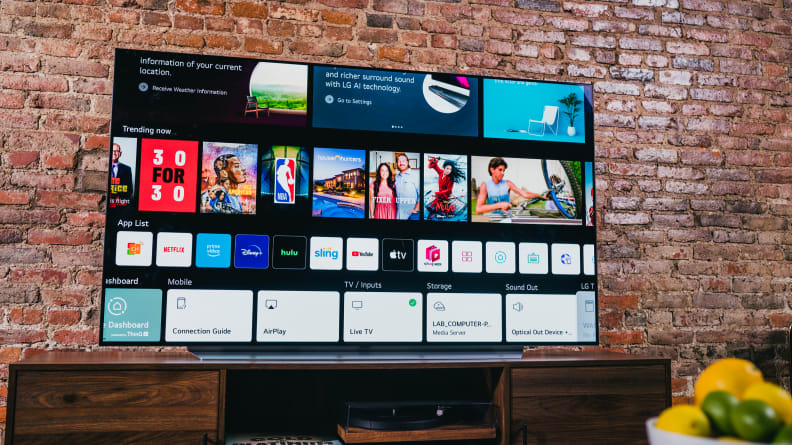
In addition to its impressive list of extra features, the C1 is equipped with the latest version of LG's webOS smart platform.
While both TVs support HDR, only the C1 is compatible with Dolby Vision, and since Dolby requires proof of a certain performance pedigree in order for TVs to include Dolby Vision, it’s considered by most to be the best brand of HDR. While Samsung TVs aren’t Dolby Vision-compatible, the QN90A does get you HDR10+, a dynamic metadata version of the HDR10 format often thought to be Dolby Vision’s closest competitor.
Samsung’s rocky relationship with Dolby means that the QN90A also lacks native Dolby Atmos—the gold standard in home theater surround sound. The C1, on the other hand, can decode Dolby Atmos audio natively. However, both models can pass it via eARC to Dolby Atmos soundbars—either in the uncompressed format (Dolby TrueHD) or the compressed format (Dolby Digital Plus).
Both TVs also offer highly sought-after gaming features like Auto Low Latency and Variable Refresh Rate, and thanks to their native 120Hz refresh rates, both support 4K gaming at 120fps. In addition, since all four of these TV’s HDMI ports support the HDMI 2.1 standard, these features are available across all points of connection.
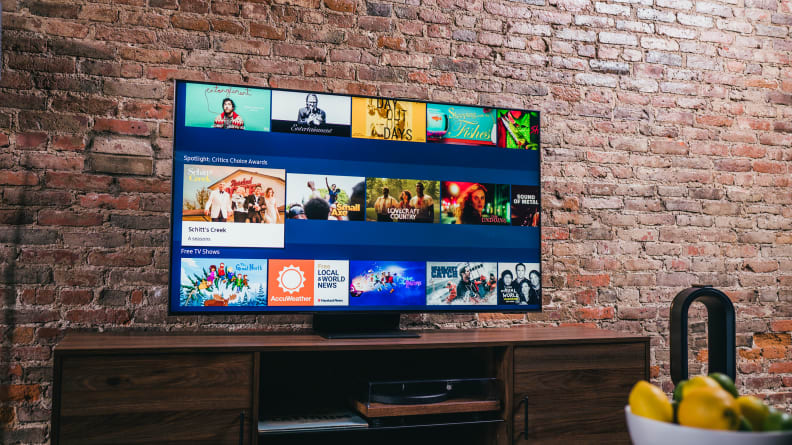
The QN90A features the newest iteration of Samsung's Tizen-based smart platform.
The C1 runs the newest version of web OS, LG’s long-running smart platform. The QN90A is equipped with the newest version of Samsung’s smart platform, Smart Hub, which is built on the Tizen operating system. Both of these platforms offer roughly the same functionality, similar app libraries, and standard navigational experiences. That said, Samsung’s software suite comes with a few nifty extras that some folks might appreciate: namely, Samsung Health, a selection of fitness programs that link with other Samsung products, and Multi View, which allows you to view multiple sources at the same time.
Still, a few extra bells and whistles on Samsung’s side can’t quite make up for the TV’s lack of Dolby Vision support—especially if you’re somewhat of a cinephile. Make no mistake: Both the C1 and the QN90A are packed with extensive toolboxes of web-based features and gaming-related goodies, but the C1 is the full package, if only by a hair.
Our pick: LG C1
Performance
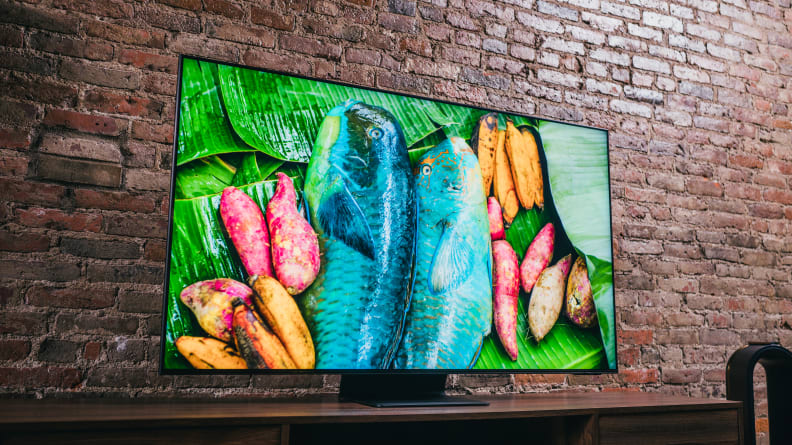
While the QN90A doesn't offer perfect black levels like the C1, it's far, far brighter than any OLED. Its colors really pop in HDR.
Although the C1 and the QN90A are two of the best TVs we’ve seen this year, their respective pictures tell wildly different stories, and exactly how they differ should inform your decision-making process.
The QN90A’s LED display is built for color and brightness, but it's packed with a complicated array of hardware that carefully dictates how and where that brightness ought to be doled out. Dubbed “Neo QLED,” it’s a combination of quantum dots (microscopic nanocrystals that enhance color fidelity) and mini-LEDs (extra-small LED backlights whose abundance offers tighter contrast control).
The combination of these two impressive technologies ensures two things: first, that the QN90A’s color production is absolutely spectacular (particularly while watching HDR content), and second, that the QN90A’s high-octane brightness (up to 1,600 nits in its most-accurate picture mode) does not interfere with the TV’s ability to get dark.
The QN90A’s mini-LEDs are so bountiful—and so expertly conducted by Samsung's dimming software—that instances of light bloom are few and far between. In fact, the only time things get a bit hairy is when you’re viewing the QN90A at an off-angle. This huge brightness, even during SDR content, also makes the QN90A an excellent choice for combating window glare and room lights.
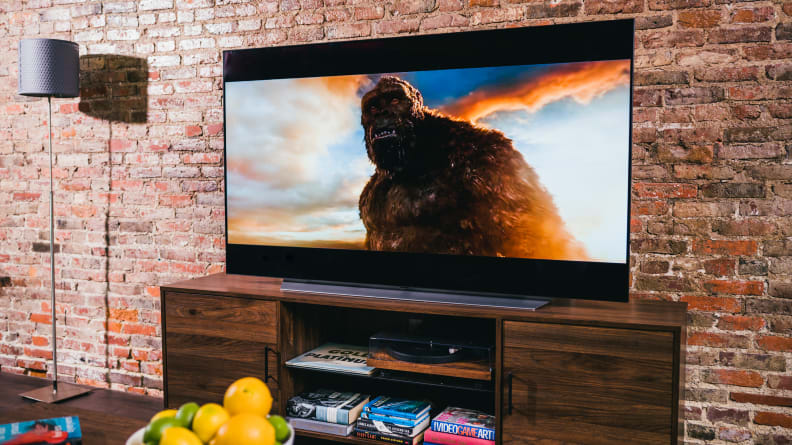
Being an OLED TV, the LG C1 can't get nearly as bright as a traditional LCD/LED TV like the QN90A, but its capable of perfect black levels, which create a staggering amount of picture detail.
The LG C1, on the other hand, is an OLED (Organic Light Emitting Diode) TV, meaning each pixel is self-illuminating. So while the QN90A relies on several hundred mini-LED zones, the C1 harnesses millions of zones in the form of individual pixels. This allows for perfect black levels that simply cannot be replicated on an LED TV like the QN90A, which has a cascading effect on the overall picture. OLED TVs, by way of their design, also tend to have much better horizontal and vertical viewing angles than LED TVs, and that’s still the case here.
Colors on the LG C1 are nothing short of incredible, too; like the QN90A, the C1 covers about 97% of the expanded HDR color gamut (DCI-P3), and even garden-variety cable TV shows are delivered with rich, highly saturated hues.
Unfortunately, the C1’s incredible black levels come at the expense of the overall brightness. While it gets significantly brighter than most mid-range LED TVs, it won’t get much brighter than around 750 nits—roughly half as bright as the QN90A. Both offer incredible contrast, but how they go about producing such contrast is entirely different.
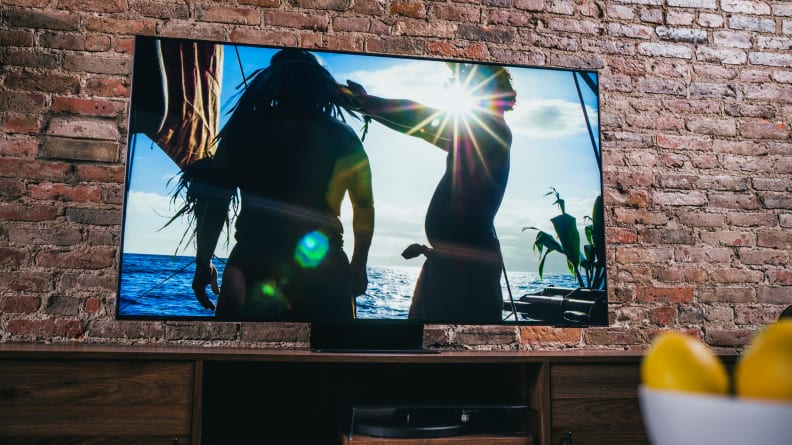
The QN90A is a better fit for bright rooms.
So what does this mean for you? Well, if you’re planning on putting your new TV in a room that gets a great deal of sunlight (or if you simply have a well-lit home), the QN90A is most likely a better fit—at least as far as performance is concerned. If your living space allows for more of a darkened home theater-type arrangement, or if you need the widest viewing angles to accommodate a very large/crowded room, the C1 will probably suit you better.
Ultimately, though, it all comes down to personal preference—which paragon of premium TV performance do you want to experience? Do you want to plunge into the inky-black depths of OLED, or do you want to zone out to the psychedelic light show of Samsung’s Neo QLED technology?
There’s more to a TV’s performance than brightness, black level, and color, but when looking at these two heavyweights, it all comes down to which flavor of fantastic is right for you.
Our pick: Draw
And the winner is…
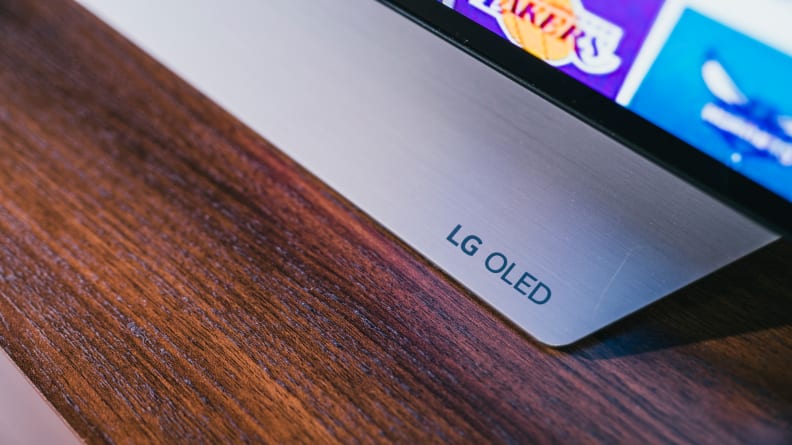
The LG C1 4K OLED TV is the best pick for most folks shopping for a high-end flagship TV.
It’s close, but the LG C1 is the best fit for most folks shopping in this price bracket. Its impressive picture—backed by perfect black levels—is more versatile, it offers a more complete suite of features for A/V enthusiasts, and its razor-thin design is an absolute knockout, sure to impress anyone who happens to be in the room. While the QN90A’s brightness is impressive, it’s not entirely necessary if you have control over your ambient lighting, while the C1’s perfect black levels contribute to picture quality no matter what.
However, if you live in a sunny environment with pools of ambient light—or if you simply yearn for a blisteringly bright experience—the Samsung QN90A is likely the better pick. You’ll miss out on Dolby Vision, but HDR10+ gets you most of the way there. Plus, you’re still landing an absolute beast of a TV for gaming and cinema, and one that’ll surely look good in nearly all situations.


